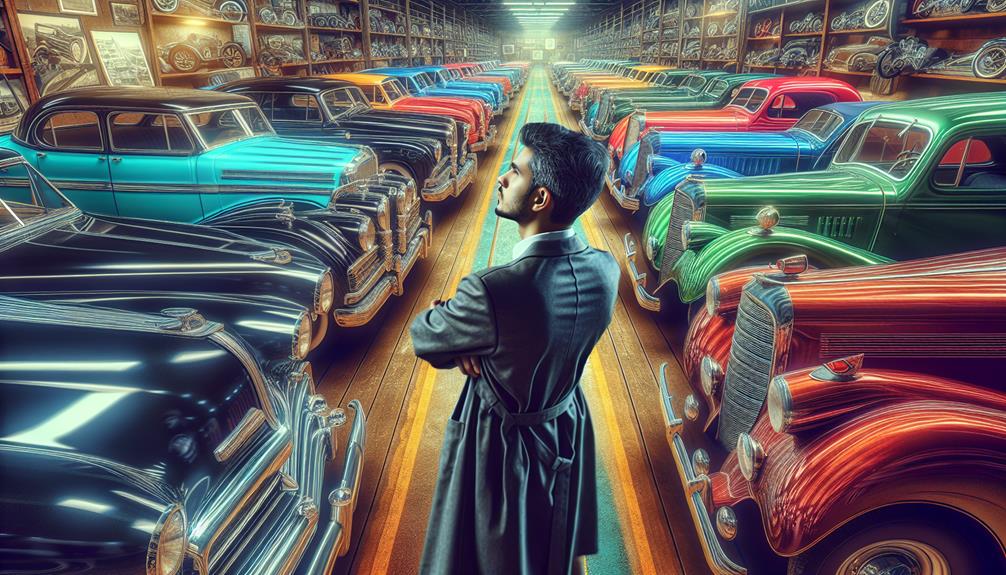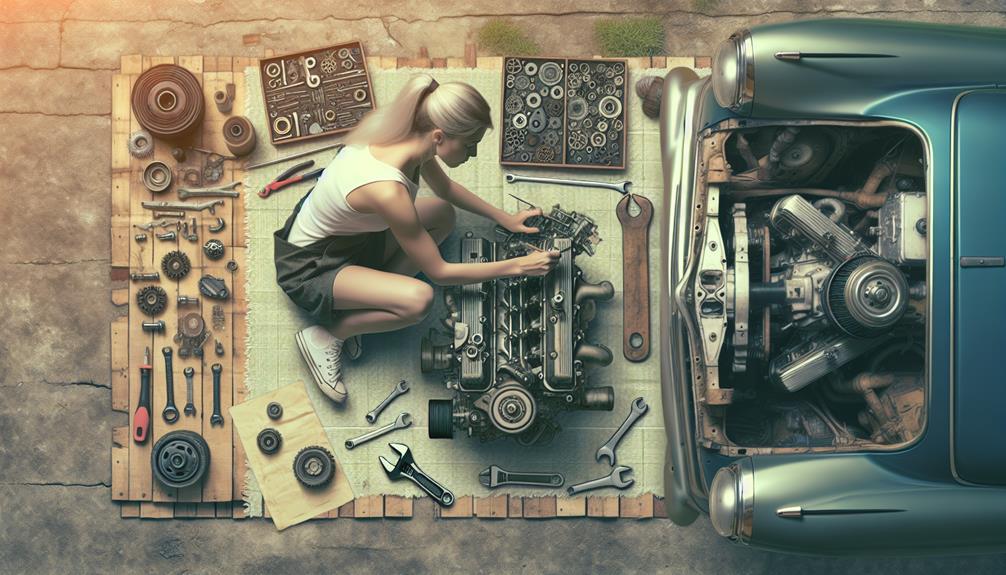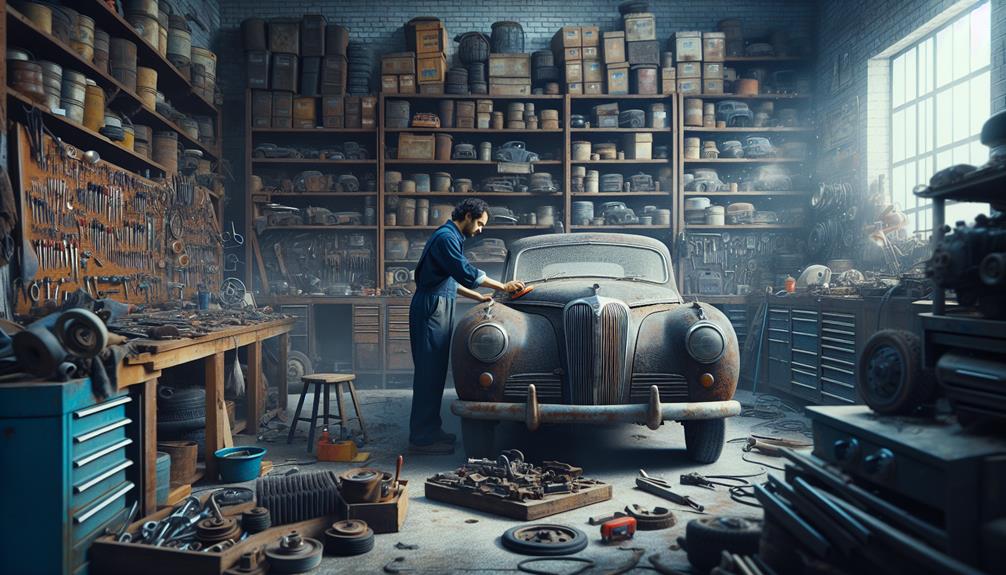You, the eager beginner, find yourself standing before a rusty relic of the past, its faded glory juxtaposed with the potential for a magnificent resurrection. Vintage car restoration may seem like a daunting task, but fear not, for this step-by-step guide is here to steer you in the right direction. From choosing the right vintage car to restoring and reassembling it, we will take you on a journey that combines the thrill of uncovering hidden treasures with the satisfaction of turning back the hands of time. So, buckle up and prepare for a ride like no other, as we embark on an adventure that will ignite your passion for vintage cars and leave you yearning for more.
Key Takeaways
- Research and gather resources from reputable suppliers, salvage yards, and online forums to ensure a successful vintage car restoration.
- Thoroughly inspect the condition of the car, including body panels, undercarriage, and engine performance, to create a detailed list of necessary repairs.
- Plan and budget for the restoration by finding affordable materials, exploring salvage yards for original parts, and considering cost-saving measures.
- Disassemble and clean the car, removing trim and using appropriate techniques to remove rust, before starting the restoration process.
Choosing the Right Vintage Car

So you’ve caught the vintage car bug, and now you’re on the hunt for the perfect classic ride to restore. Buckle up, because we’re about to dive into the exciting world of choosing the right vintage car!
When it comes to vintage car restoration, one of the first decisions you’ll face is whether to restore or replicate. Restoring involves bringing an old car back to its original glory, while replicating involves creating a new car that looks like a vintage model. Both options have their pros and cons. Restoring allows you to preserve the authenticity and history of the car, but it can be more time-consuming and costly. Replicating, on the other hand, gives you the freedom to customize and modify the car to your liking, but it may lack the original charm.
Once you’ve settled on whether to restore or replicate, the next step is sourcing vintage car parts. Finding original parts can be a challenge, but it’s essential for maintaining the integrity of the car. Start by researching reputable suppliers and salvage yards that specialize in vintage car parts. Online forums and classified ads can also be valuable resources. Don’t be afraid to ask fellow enthusiasts for advice or recommendations.
Assessing the Condition of the Car
Now that you’ve decided whether to restore or replicate your vintage car, it’s time to get up close and personal with the vehicle itself and assess its condition. This is where the real adventure begins! Grab your flashlight and magnifying glass because we’re about to become vintage car detectives.
First things first, let’s talk about rust. Rust is the enemy of any classic car enthusiast. It’s like a sneaky saboteur that slowly eats away at your beloved vehicle. Take a close look at the body panels, undercarriage, and any hidden nooks and crannies. Look for signs of bubbling paint, flaking metal, or any suspicious discoloration. Rust can be tricky to spot, so make sure to thoroughly inspect the entire car.
Once you’ve evaluated the rust damage, it’s time to identify the necessary repairs. Start by making a detailed list of all the issues you’ve discovered. Is the engine running smoothly? Are there any leaks? How’s the suspension? Don’t forget to check the electrical system as well. It’s important to have a clear understanding of what needs to be fixed before diving into the restoration process.
Planning and Budgeting for the Restoration

Time to put on your thinking cap and grab your calculator because we’re about to dive into the exciting world of planning and budgeting for your vintage car restoration. Restoring a vintage car can be a labor of love, but it can also be a drain on your bank account if you’re not careful. So, let’s talk about finding affordable restoration materials and some tips for saving money during the process.
When it comes to finding affordable restoration materials, there are a few options you can explore. First, consider joining online forums or local car clubs where enthusiasts often buy, sell, and trade parts. You might be surprised at the hidden gems you can find at a fraction of the cost. Additionally, don’t forget to check out salvage yards or junkyards for original parts that can be cleaned up and reused.
Now, let’s talk about saving money during the restoration process. One of the best ways to save is by doing as much of the work as possible yourself. Enlist the help of friends or family members who have mechanical or bodywork skills, or take advantage of online tutorials and DIY videos. By putting in the elbow grease yourself, you can save a significant amount of money on labor costs.
Another way to save money is by prioritizing the restoration tasks. Instead of trying to tackle everything at once, focus on the most critical areas that need attention. This way, you can allocate your budget more effectively and prevent overspending.
Disassembling and Cleaning the Car
Get ready to roll up your sleeves and get down and dirty because it’s time to start disassembling and cleaning your vintage car. This is where the real fun begins! Before you can unleash the car painting techniques and make your ride shine like a star, you need to strip it down to its bare bones. Start by removing all the exterior trim, lights, and bumpers. Don’t forget to label everything so you don’t end up scratching your head when it’s time to put it all back together.
Now it’s time to turn your attention to the rusty parts. Rust removal methods vary depending on the severity of the rust, but you can start by using a wire brush or sandpaper to scrub away the surface rust. If the rust is deeper, you might need to use a rust dissolver or even consider sandblasting. Remember, removing rust is crucial before you can move on to the next step of the restoration process.
Once you’ve tackled the rust, it’s time to give your vintage car a thorough cleaning. Grab a bucket of soapy water, a sponge, and get scrubbing. Don’t forget to clean the nooks and crannies, as dirt and grime can hide in the most unexpected places. After washing, rinse off any soap residue and let the car dry completely before moving on to the next step.
Disassembling and cleaning your vintage car may seem like a daunting task, but it’s an essential part of the restoration process. So, roll up your sleeves, put on some gloves, and get ready to transform your old rust bucket into a shiny, show-stopping classic beauty.
Restoring and Reassembling the Car

Once you’ve completed the disassembly and cleaning stage, it’s time to dive into the exciting world of restoring and reassembling your vintage car. This is where the magic happens, where you bring your beloved automobile back to life. But how do you go about it? Fear not, for we have some tips and tricks to guide you through the process.
First, let’s talk about restoring techniques. Depending on the condition of your car, you may need to repair or replace certain parts. For smaller dents or scratches, you can use techniques like paintless dent removal or touch-up paint. For more extensive damage, you may need to consult a professional or search for replacement parts.
Ah, sourcing vintage car parts, a true adventure. The thrill of hunting down that elusive piece, scouring junkyards, and browsing online forums. It’s like being on a treasure hunt. But don’t worry, there are plenty of resources available. You can check out local salvage yards, specialized vintage car shops, or online marketplaces. Just remember to do your research and ensure that the parts you find are compatible with your car’s make and model.
Conclusion
Congratulations! You’ve reached the end of our step-by-step guide to vintage car restoration. Now, here’s a jaw-dropping statistic to leave you amazed: Did you know that a fully restored vintage car can sell for up to 10 times its original value? That’s right, all your hard work and dedication can pay off big time, both financially and emotionally. So, grab your tools, buckle up, and let your restoration journey begin. Remember, the road may be bumpy, but the rewards are absolutely worth it! Happy restoring!




